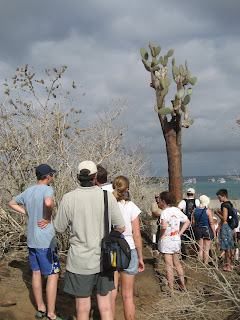Jan. 28


 It’s hard to believe that after three weeks, we are sitting here in the Guayaquil airport awaiting our departing flight. What a great time! Our final three days aboard the Floreana were perfect. We enjoyed more snorkeling, hiking, and of course minor sunburns.
It’s hard to believe that after three weeks, we are sitting here in the Guayaquil airport awaiting our departing flight. What a great time! Our final three days aboard the Floreana were perfect. We enjoyed more snorkeling, hiking, and of course minor sunburns.As you can see from these photos, the landscapes of the islands
 were amazing. We spent the morning hiking to the highest point on Bartholemew and enjoying the views of Pinnacle Rock. We then moved over to Sullivan Bay. This is the most recent island to experience volcanic eruption, the last being 120 years ago, and the lava fields were rapidly cooled to maintain the texture.
were amazing. We spent the morning hiking to the highest point on Bartholemew and enjoying the views of Pinnacle Rock. We then moved over to Sullivan Bay. This is the most recent island to experience volcanic eruption, the last being 120 years ago, and the lava fields were rapidly cooled to maintain the texture.
 The crew of the Floreana was great and treated us to an evening of dinner and dancing. With Captain Freddy and Marjorie leading us in dances, we kept the boat rocking as we attempted to keep up. We retired for the evening so that we would be ready early in the morning for a panga ride into Black Turtle Cove. Our last morning was a sunrise show of sea turtles and baby sharks in the mangrove lagoon.
The crew of the Floreana was great and treated us to an evening of dinner and dancing. With Captain Freddy and Marjorie leading us in dances, we kept the boat rocking as we attempted to keep up. We retired for the evening so that we would be ready early in the morning for a panga ride into Black Turtle Cove. Our last morning was a sunrise show of sea turtles and baby sharks in the mangrove lagoon. Thank you everyone for taking the time to read our blog and for your comments as well. Again, we want to thank everyone who has contributed to helping us make it here and has supported us. We look forward to seeing you and talking to you tomorrow!
Thank you everyone for taking the time to read our blog and for your comments as well. Again, we want to thank everyone who has contributed to helping us make it here and has supported us. We look forward to seeing you and talking to you tomorrow! 














































